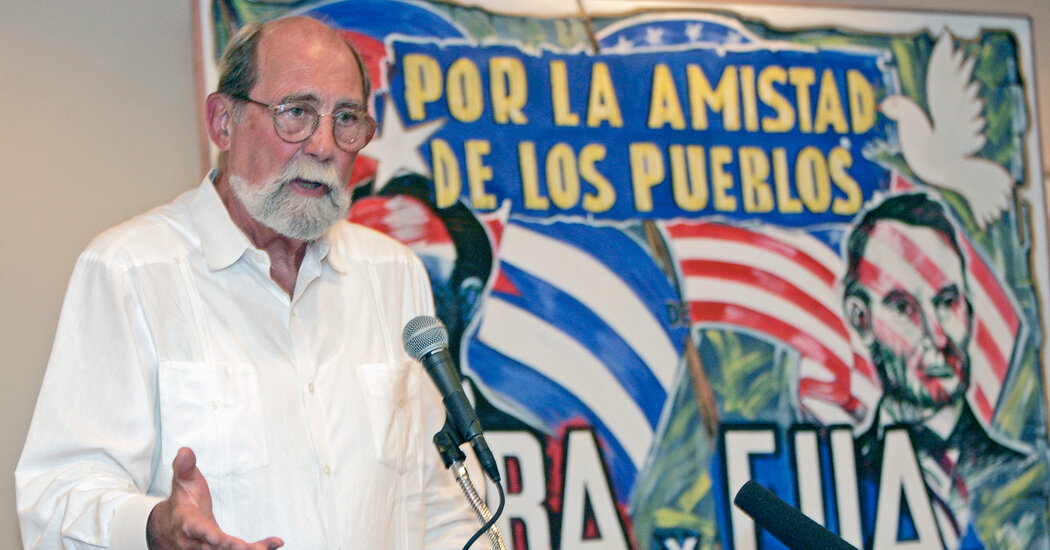Wayne S. Smith, a veteran Cuba expert at the State Department who, after resigning in protest over America’s embargo against the island nation in 1982, spent nearly four decades leading efforts to rebuild relations between Washington and Havana, died on June 28 at his home in New Orleans. He was 91.
His daughter, Melinda Smith Ulloa, said the cause was complications of Alzheimer’s disease.
For more than 24 years after he joined the Foreign Service in 1958, Mr. Smith was America’s man in Havana, whether he was physically in the Cuban capital or dealing with it from a desk in Washington.
Later, after leaving the State Department, he used his extensive experience to carry out a sustained campaign against America’s strategy of isolating Cuba, while also leading private and congressional delegations to the island in an attempt to build avenues of dialogue.
“He was one of the foremost spokespeople in favor of normalizing relations,” William LeoGrande, an expert on Cuba affairs at American University in Washington, said in an interview.
A witty and nimble writer, Mr. Smith turned out scores of opinion pieces, journal essays and books, including a memoir-cum-history, “The Closest of Enemies: A Personal and Diplomatic Account of U.S.-Cuban Relations Since 1957,” published in 1987.
“Cuba seems to have the same effect on U.S. administrations,” he liked to say, “as the full moon once had on werewolves.”
Mr. Smith first arrived in Cuba in the midst of the revolution against the government of Fulgencio Batista. After the government fell on Jan. 1, 1959, he oversaw the evacuation of U.S. citizens from Cuba — including the future actress Kathleen Turner, whose father worked at the embassy.
He became a vocal critic within the State Department of America’s hardening stance against Cuba, and he was among the officials selected by President Jimmy Carter in 1977 to reopen relations. Two years later Mr. Carter sent him to Havana to run the United States Interests Section, which represented the U.S. in lieu of an embassy.
Mr. Smith was no fan of the Cuban regime. But he believed in the power of diplomacy and dialogue, and firsthand experience convinced him that the embargo was self-defeating and counter to America’s interests.
The arrival of Ronald Reagan to the White House signaled a hardening of U.S. policy against Cuba, based in part on the assessment that Fidel Castro, the island nation’s leader, was funneling arms to leftist guerrillas in Central America.
Mr. Smith fired off a series of critical cables to the State Department; the department, in response, tried to shift him to a new post in Uganda. Incensed, he resigned in protest in August 1982.
Weeks later, he published a jeremiad in the magazine Foreign Policy, accusing the administration of “myopia” on Cuba for continuing what he said was a long tradition of errors.
“The administration is determined to make past mistakes all over again,” he wrote. “Its approach to the Cuban problem is as hackneyed as it has been unsuccessful and evokes a powerful sense of déjà vu.”
Wayne Sanford Smith was born on Aug. 16, 1932, in the town of Seguin, Texas, east of San Antonio. His mother, Opal (Baldwin) Smith, managed the home; his father, Paul Smith, was an oil field engineer, a job that kept the family moving around Texas and Oklahoma throughout Wayne’s childhood.
After graduating from high school at 16, he persuaded his father to sign papers allowing him to enlist in the Marines as a minor. He served in combat during the Korean War, then as a drill instructor at Parris Island, S.C., one of the Marines’ primary training sites.
He received an honorable discharge in 1953, after which he enrolled at Mexico City College (now part of the National Autonomous University of Mexico) on a football scholarship.
In 1957 he joined the State Department, where he worked on Cuban and Latin American affairs. He passed the Foreign Service exam in 1958.
He married Roxanna Phillips, who also worked at the State Department, in 1958, just before being dispatched to Cuba — their trip south, by car and boat, became their honeymoon. She died in 2014.
Along with their daughter, he is survived by their son, Sanford, and two grandchildren. A previous marriage, to Jacqueline Richard, ended in divorce, and a son from that union, Michael Smith, died before him.
Mr. Smith also served assignments in Argentina and Brazil. He received two master’s degrees from Columbia, in philosophy and international relations, both in 1962. He also earned a Ph.D. in political science from George Washington University in 1977.
After retiring from government, he worked as a fellow at the Carnegie Endowment for International Peace, taught at the School for Advanced International Studies at Johns Hopkins University, and in 1992 joined the Center for International Policy, a progressive think tank, as a senior fellow.
The embargo against Cuba remains, and in that sense Mr. Smith did not live to see his efforts succeed. But in 2015 the United States restarted relations with Cuba and reopened its embassy. Mr. Smith was on hand in Havana to watch the flag-raising ceremony.
“Cuba had been my life,” he said in a video interview with The New York Times in 2015. “I was there when we broke, so I’d like to be there again when we haul the Stars and Stripes above the old embassy. It will be a wonderful day for all of us, but especially me, because I was there when we pulled the flag down.”
